‘I met Shree Maa in the Spring of 1996, when my wife asked me to accompany her to a friend’s house where the saint was visiting,’ recollects Charles Seward. ‘When we arrived everyone was singing, ringing bells and dancing about the room. I thought, “Is this a wild party, or a spiritual gathering?” Trying not to feel out of place, I sat in the back of the room and watched. There were song sheets but I could not pronounce the words which were in Sanskrit. The atmosphere was alive with a kind of infectious loving, joyful feeling. Slightly out of character for me, my hands started to slap my crossed legs, and before long my knees were bouncing, my head waving and my hands clapping. My heart started to open, as the boundaries that separated me from others faded. The whole experience contained a great sense of elation.
‘A line of seated aspirants had formed about ten feet in front of Shree Maa and Swami Satyananda. The air was charged with energy and everyone was anxiously waiting to meet the Divine Mother and to receive her blessings. As my wife and I moved closer in the line the intensity of good feeling began to increase. It became clear that the small thin Bengali woman in front of us was at the source of the wake up calls.
‘A year later, in the Spring of 1997, while touring the United States with Shree Maa, I had the opportunity to see hundreds of people undergo a similar experience to mine. They would simply come to see Mother and their hearts would begin to soar. Almost without exception they would leave with a greater inspiration to pursue divine life. Even the tightest, most in-the-head people would melt after two or three meetings.’
Seward’s memories embrace not only the spiritual gatherings but also the every-day aspects of that journey across the US. ‘The beauty of the American countryside, slipping by silently outside of the van windows, is somehow heightened by Shree Maa’s presence. Even while travelling by van, Maa’s primary focus is on God. Time is passed reading scripture, singing devotional songs and discussing spiritual issues. Gossip is always discouraged. Mother has definitely mastered the art of economising words. It is amazing how the most complex questions can be answered profoundly with a few words. Many people have seen her loving and joyful character but travelling with her affords an insider view of her truly playful nature.’
It was in 1997 that David Sylvian would first meet Shree Maa, during a time when he and Ingrid were happily settled into life as a family and from which Dead Bees on a Cake was borne. ‘Moving to Minneapolis was important in that it felt like a retreat,’ Sylvian said. ‘I needed to move away from England. The sense of renewal that went with the move was wonderful. Recording the album seemed part and parcel of life in the house. I was taking care of the children, working on material whenever I had a free moment. It was just part of family life in that house. Maybe I should have been more disciplined. But it just became another facet of our lives together. Also in the same period, I started seeing different teachers in different parts of the world, and that began to have an influence on my outlook.’
Shree Maa’s travels that year were recorded in an account posted online and subsequently shared on one of the fan-run Sylvian news sites. ‘Maa always carries Ramakrishna in her heart, and his spirit pours out of her everywhere she goes. Every room she enters, every street she graces, blazes with her devotion. Such was the case this year when Shree Maa, Swami Satyananda and other members of the Devi Mandir family embarked on a tour of the United States.’ Swami Satyananda Saraswati is a long-time devotee and teacher who first met Shree Maa at a temple in the village of Bakreshwar in West Bengal. ‘She looked me in the eye,’ he recalled, ‘and I knew her immediately. She was the deity that I had been worshipping.’ The ashram family who gathered around Shree Maa when she and Swami subsequently moved to the United States would be known as the Devi Mandir.
The 1997 US tour included a stop at David and Ingrid’s home. ‘Shree Maa actually came to our house in Minneapolis to stay for a period of time, and that was a tremendously transforming experience…She brought about thirteen people with her, and they camped out in the house for a while, and it kind of turned into an ashram for about a week.’
It was another encounter with an Indian holy woman following on from the couple’s visit to Mother Meera (see ‘Thalheim – The Church Bells Strikeʼ) and their by now established devotion to Mata Amritanandamayi (Amma) as guru. Sylvian’s new album would be imbued with the intimacy, love and challenge that he found in these women and their teachings. The visit turned the home into ‘a place of worship’ and his fascination with Shree Maa’s story and example was evident. ‘She was born in India into a family of renown,’ Sylvian explained, ‘but at an early age she just walked away from all that to walk into the forest of India and turn her back on materialistic life, and devoted herself to God. She lived in the Himalayas for a period of time. She became Shree Maa, this holy woman through devotion. She came to America in 1984; she had a very reclusive life, very humble existence, still does.’
A first-hand account from one of the visitors was posted in the online journal: ‘Minneapolis, Minnesota was a wonderful city. At one point early in the evening, at the home of our hosts [David and Ingrid], Mother sang to God for two hours. We were lucky enough to witness her absorption in song. Rarely do you hear the power of the heart crying for Darshan, holy communion. Maa is the greatest devotee of any one. All is for her guru, God.’
The next-to-last track on Dead Bees on a Cake, ‘Praise’, captures forever a memory of those few days under the Sylvians’ roof. ‘She used to sing the piece on the album every morning at the end of puja – worship,’ said David. ‘It was always so moving, the voice very fragile echoing through the house. This yearning, it was just tremendous.’
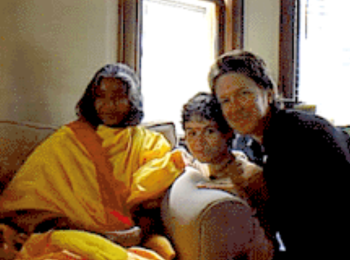
‘It was so moving, it was so pure. Just to aspire to that purity, that openness, that love for life, for God, however you want to name it, was really something…Just being around the presence of people like that, that have so much love for life, they understand the shadow too and they understand the difficulties that the world is going to face, but that doesn’t deter them in terms of their focus and what has to be done.
‘Having the studio upstairs we asked her if she wouldn’t mind…and she blessed me by performing the piece knowing full well that I would include it on the album.’
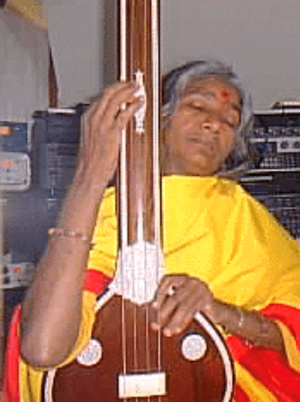
‘The song she is singing in ‘Praise’ is a song to the Divine Mother,’ said Sylvian. ‘Each verse deals with a different aspect of the Divine Mother. But it is basically a song of praise to each aspect. It is something that is normally sung after a period of worship. So the first line would be ,“in the morning I bow down to…” and then it would say the name of the particular aspect, and go on to list those aspects.’
‘It is sung in Sanskrit.’
The first words that we hear sung give us a description of the piece:

A Song of Praise to the Supreme Goddess

In the morning I remember the Foremost, She who shines like the autumn moon, wearing a shining necklace and earrings studded with fine jewels. She holds divine weapons in Her thousand arms of excellent blue, She gives divine life. The soles of her feet are red like a lotus. She is the Highest Divinity.
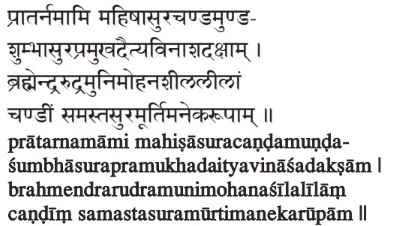
In the morning I bow down to the Foremost, to the Slayer of the Great Ego, Anger and Passion, and the Destroyer of other negativities of duality led by Self-Conceit. Her graceful activities delude even Brahmā, the Creative Consciousness, Indra, the Rule of the Pure, Rudra, the Reliever of Sufferings, and other wise beings. She is Chaṇḍī, She Who Tears Apart Thought, the image of divinity to all the Gods in so many forms.
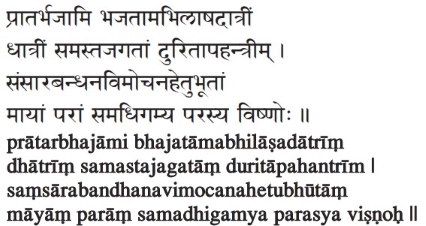
In the morning I laud the Foremost, the Fulfiller of all Desires for those who worship, the Creator of all the worlds and Remover of all difficulties. Take away all the bondage from the world of objects and relationships, and bring us to the pure intuitive vision of the Supreme Consciousness that resides beyond Māyā.
These words are taken from the Chandi Path, a text drawn from chapters 81 to 93 of the Markandeya Purana, one of the revered scriptures of Hindu spirituality. The English versions above are from Swami Satyananda Saraswati’s own translation. As the hymn of praise closes, we hear Shree Maa repeat a mantra – ‘Om Hrim Chandikayai Namah’. This japa would be repeated by devotees 108 times as part of worship, promoting the concentration of the mind, their practice typically aided by mala beads strung with either 108 or 27 beads (being one fourth of the 108 repetition).
The song was of lasting significance to David and Ingrid. ‘It became something that we would play at the end of our worship. I finally added the guitar part to it, and it just seemed to lift it. It’s been an important piece to us, not just in terms of our practice, but as an example of true devotion. Shree Maa is a truly devoted soul, so it’s wonderful to be able to incorporate that into the album. It’s not something I could possibly project myself. I enjoy the shadow and light in my own work, but her work is just pure light.’
There is an interchangeability between the expression of love for a human partner and the expression of devotion to the divine throughout Dead Bees on a Cake. Shree Maa’s teaching reveals that this goes deeper than merely being a creative device allowing the compositions to be interpreted in two different ways. ‘She encouraged us to live our lives that way, to look for the divine in one another and worship the divine in one another. Which I think is a really wonderful way to conduct a relationship. And also in your children and all beings essentially. It has become a discipline or practice to look into your loved one’s eyes and find that aspect of their being.’

What better way to express these experiences than to include Shree Maa’s voice directly on the album he was producing? ‘That’s like a song of pure love, yearning for the divine, and appreciation of the divine,’ Sylvian said. ‘Ultimately it felt right to include this as part of the album as Shree Maa seems to be the example of the goal. She can sing with such clarity of devotion, just purity. She’s the focal point of the album, the pinnacle if you like.’
An interviewer enquired whether the recording of ‘Praise’ was his gift to the listeners? ‘She’s the Gift. She’s giving of herself to everybody. It’s her grace.’
Sylvian’s looping guitar accompaniment somehow perfectly offsets the vocal. Was it difficult to find the right sounds and sequence given the use of unfamiliar Indian scales? ‘No actually, it came to me very easily. She sang the piece unaccompanied and she has wonderful pitching. So no, it was actually quite easy to come up with a chord sequence for it.’
After Shree Maa and the folk from Devi Mandir had moved on from Minneapolis, everything came up for re-evaluation. In October 1997 it was reported that Holger Czukay, when asked about his friend, had shared that David and Ingrid were leaving Minnesota for California. ‘One month after arriving,’ said Sylvian on the Time Spent promotional film for Dead Bees on a Cake, ‘on Oct 28th, our second daughter, Isobel Ananda, was born.’
‘I made the move to Napa to be closer to one particular teacher, Shree Maa,’ Sylvian explained. ‘Minneapolis was a retreat from so many things – just isolating myself I think people had the impression that I led a very isolated life here in London, but it wasn’t true. In Minneapolis I did. I had very few friends. And that’s just the way I wanted it. I led a very quiet existence, totally focused on family. Wonderful: they were five rich years that were the happiest of my life. And then we retreated to the Napa hills as a family and worked closely with Shree Maa’s ashram, which is still there, for a period of months, before moving once again further along the valley. There were periods of time where that was all our focus was, the spirituality.’
A Marcus Boon essay on Sylvian’s official site goes as far as saying that the family lived with Shree Maa in California for a period, so perhaps for those months they took up residence within the ashram site in Napa, situated on a ‘rustic hillside which straddles both sides of a seasonal creek,’ occupying ‘an eighteen-acre parcel of land in the mountains of above Lake Berryessa, a little more than an hour’s drive from San Francisco.’
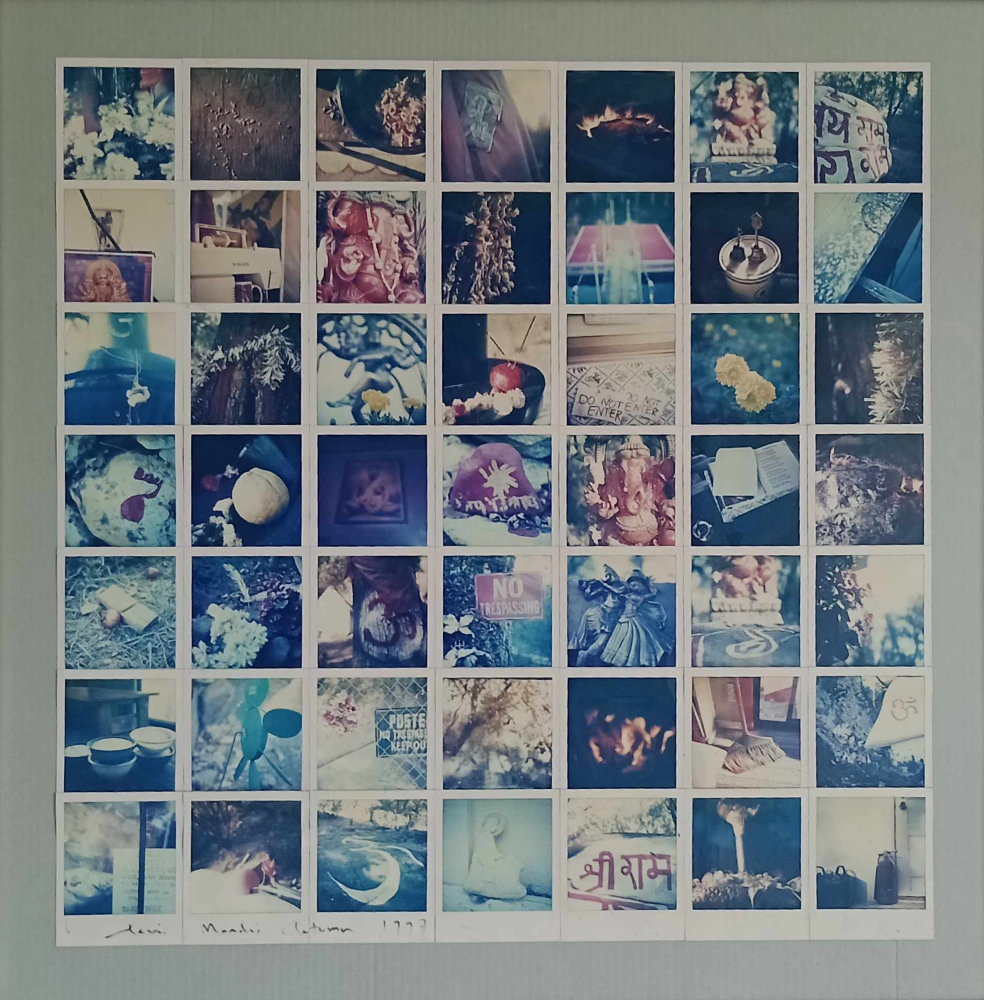
Such was the allure of these spiritual explorations, Sylvian nearly walked away from his work-in-progress album and life as a musician completely. ‘On asking Shree Maa whether I should abandon a life in music, a public life, I was told that music was my sadhana, my means by which growth is achieved. Both Ammachi and Shree Maa pushed me back out into the world to continue my engagement with it. It renewed my focus and gave me a different slant on being a public figure, however minor.
‘I may have been guilty up until that point of separating the spiritual aims and those of my public life. I recognised that nothing falls outside of spiritual life and practice – nothing at all – and it’s this realisation that enables me to maintain perspective and balance in all that I do, and in all the roles that I find myself playing. At root comes the notion of surrender and from this everything else follows.’ (DS, 2005)
Another beautiful piece sung by Shree Maa is her unaccompanied rendition of a further devotional text from the Chandi Path, ‘The Song that Gives the Key to Perfection’. It’s a fitting companion to ‘Praise’. Sylvian later released his own sung version of this piece on the cd that came with the programme for his Everything and Nothing tour in 2001/2002 and it was subsequently included on Camphor.
Footnote:
Sadly in late August 2020 the Devi Mandir ashram in Napa was destroyed by the Californian wild-fires. The Temple, dharmashala, kitchen, Shree Maa’s house and all of the outbuildings were reported to have been burned completely to the ground. The utility, water, and sewer lines were destroyed making the Napa property completely uninhabitable. In the immediate aftermath, Swami Satyananda Saraswati wrote, ‘While each of us will experience this sadness in our own way, I want to encourage you to look for the positive as well. Please find in this the inspiration to move forward with Shree Maa and me and our entire Devi Mandir Family into a new beginning…’
‘Praise (Pratah Smarami)’
Shree Maa – vocal; David Sylvian – guitars
Text traditional, music by Shree Maa
Arranged and produced by David Sylvian. From Dead Bees on a Cake, Virgin, 1999.
All quotes by David Sylvian are from interviews conducted in 1999 unless indicated. Charles Seward’s recollections are from Shree Maa – The Life of a Saint by Swami Satyananda Saraswati, Devi Mandir publications, 1997 (Amazon). The text of ‘Pratah Smarami’ in Sanskrit with English translation is from Chandi Path by Swami Satyananda Saraswati, Devi Mandir publications, 1981 (Amazon). Full sources and acknowledgements for this article can be found here.
Many thanks to Neil Arnold for contributing the image of the ‘Devi Mandir, Autumn 1997’ polaroid collage from his private collection.
The featured image is from the gallery at shreemaa.org
Download links: ‘Praise (Pratah Smarami)’ (Apple), ‘The Song that Gives the Key to Perfection’ (sung by Shree Maa) (shreemaa.org free download)
Physical media links: Dead Bees on a Cake (burningshed) (Amazon)
An extended vinyl version of Dead Bees on a Cake was released in 2018 (Amazon)
‘At the end of each morning she would sing the song. Her voice resonated through our house, it was magnificent. It was so deeply moving. I have a studio in the house and she very gracefully allowed us to record her. We captured something that was a very important document for us. It became part of our practice we would listen to that piece over and over again on daily basis.’ David Sylvian, 1999

More from Dead Bees on a Cake:
I Surrender
Thalheim
Pollen Path
All of My Mother’s Names (Summers with Amma)
Darkest Dreaming
The Scent of Magnolia
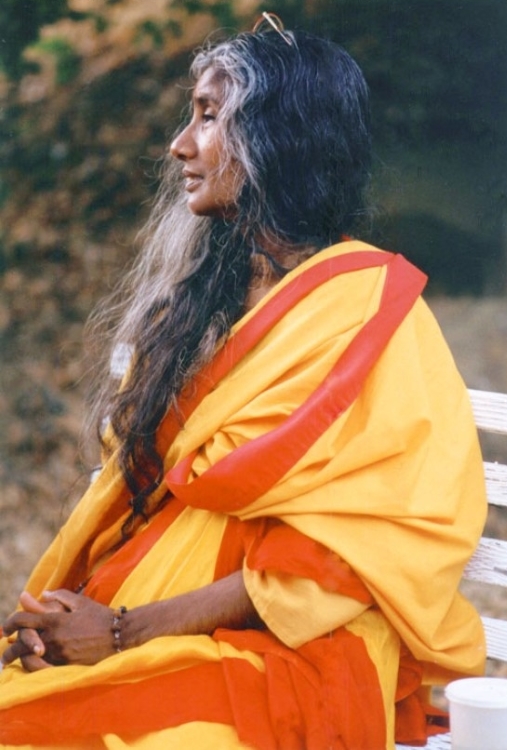
David’s house near Lake Calhoun in Minneapolis
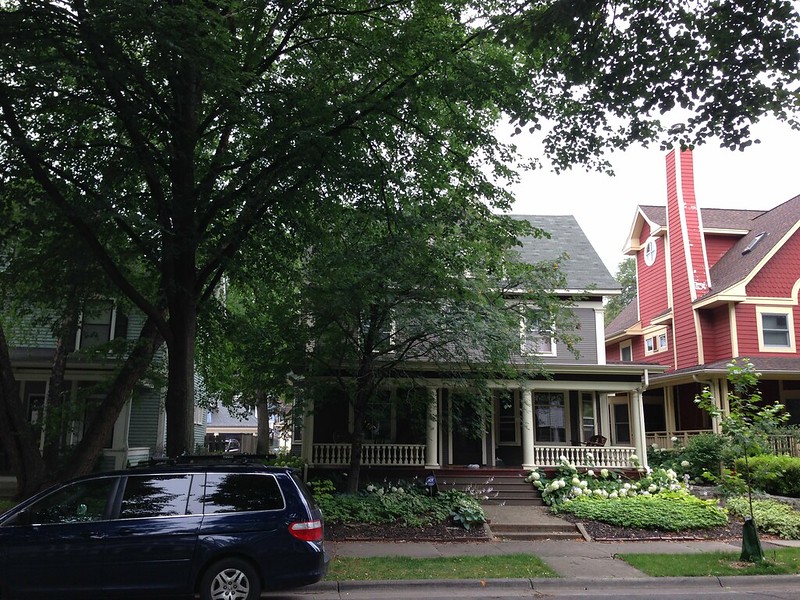

LikeLiked by 1 person
David, you do realise that this is actually Ingrid reciting a recipe for Pineapple Upside Down cake played backwards, don’t you?
LikeLike
There’s no answer to that…!
LikeLike